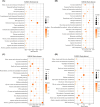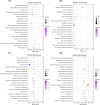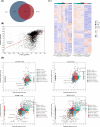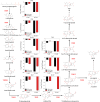Citric acid impairs type B trichothecene biosynthesis of Fusarium graminearum but enhances its growth and pigment biosynthesis: transcriptomic and proteomic analyses
- PMID: 40366181
- PMCID: PMC12175541
- DOI: 10.1128/aem.01531-24
Citric acid impairs type B trichothecene biosynthesis of Fusarium graminearum but enhances its growth and pigment biosynthesis: transcriptomic and proteomic analyses
Abstract
Fusarium graminearum is a pathogenic fungus that causes devastating plant diseases such as Fusarium head blight, leading to significant food waste and posing a threat to human health due to the accumulation of mycotoxins. As a soil-borne fungus, F. graminearum interacts closely with plants and soil, completing its life cycle in an intricate environment. In this investigation, citric acid (CA), a plant root exudate and heavy metal chelator, was investigated for its effect on F. graminearum at concentrations of 2.5, 5, 10, and 20 mM. The fungus treated with this CA gradient exhibited different growth conditions and mycelial colors. Integrative analysis of transcriptomics and proteomics found that the growth of the fungus was accelerated by the upregulation of carbon source metabolism-related enzymes such as phosphoenolpyruvate carboxykinase (PEPCK), Glpk, and LAI12, and the mycelial pigments were altered by polyketide biosynthetic enzymes like AurF, AurJ, and AurT, which were responsible for the production of aurofusarin and rubrofusarin. Interestingly, many Tri genes and their corresponding proteins along with type B trichothecene biosynthesis were significantly downregulated, though the fungal growth was promoted. In this study, the CK, 2.5, and 5 mM groups had similar expression patterns of RNA and protein, while the 10 and 20 mM groups were alike. With the validation of CK, 5, and 10 mM groups, the discovery of CA as a type B trichothecene biosynthesis inhibitor and growth promoter was expected to facilitate its reasonable application and contribute to further research for the prevention of F. graminearum.
Importance: Fusarium graminearum is a challenging phytopathogen that causes plant disasters worldwide, such as Fusarium head blight and ear rot in small grain crops like wheat and maize. Besides, the invasion of the fungus on plants is often accompanied by the production of health-threatening mycotoxins-trichothecenes. Therefore, the control of Fusarium graminearum has always been a hot area of research. However, currently, the prevalence of these plant diseases around the world and the mycotoxin accumulation beyond safety limits indicate the necessity for more related research. In the last decades, researchers have sought to identify the key substances associated with the growth, propagation, and mycotoxin production of the fungus, such as carbon and nitrogen sources. Organic acids have always been considered antifungal agents due to their abundant H+ content. However, their comprehensive impact on fungi has been rarely investigated. This research focused on the effect of citric acid, a type of crop exudate and a common heavy-metal chelator, on the metabolism of Fusarium graminearum. The result was expected to provide a theoretical basis for further studies on plants-soil-fungi interactions and the reasonable utilization of citric acid in agriculture.
Keywords: F. graminearum; citric acid; proteomic; transcriptomic; trichothecene.
Conflict of interest statement
The authors declare no conflict of interest.
Figures








Similar articles
-
Comparative transcriptomics reveal contrasting strategies between a fungal plant pathogen and an endophyte during initial host colonization.Microbiol Spectr. 2025 Aug 5;13(8):e0022625. doi: 10.1128/spectrum.00226-25. Epub 2025 Jun 12. Microbiol Spectr. 2025. PMID: 40503835 Free PMC article.
-
FG-lncRNA06490 Is a Key Factor Influencing the Pathogenesis of Fusarium graminearum.Phytopathology. 2025 Jun;115(6):676-688. doi: 10.1094/PHYTO-11-24-0378-R. Epub 2025 Jun 17. Phytopathology. 2025. PMID: 40526079
-
Ecophysiological behavior of major Fusarium species in response to combinations of temperature and water activity constraints.Appl Environ Microbiol. 2025 Jul 23;91(7):e0183224. doi: 10.1128/aem.01832-24. Epub 2025 Jun 10. Appl Environ Microbiol. 2025. PMID: 40492737 Free PMC article.
-
Trichothecenes in Food and Feed, Relevance to Human and Animal Health and Methods of Detection: A Systematic Review.Molecules. 2021 Jan 16;26(2):454. doi: 10.3390/molecules26020454. Molecules. 2021. PMID: 33467103 Free PMC article.
-
Recent insights into potato dry rot an emerging Disease: Focusing on pathogen diversity, host-pathogen interactions, and management strategies.Microb Pathog. 2025 Oct;207:107866. doi: 10.1016/j.micpath.2025.107866. Epub 2025 Jul 9. Microb Pathog. 2025. PMID: 40645351 Review.
References
-
- Khan MK, Pandey A, Athar T, Choudhary S, Deval R, Gezgin S, Hamurcu M, Topal A, Atmaca E, Santos PA, Omay MR, Suslu H, Gulcan K, Inanc M, Akkaya MS, Kahraman A, Thomas G. 2020. Fusarium head blight in wheat: contemporary status and molecular approaches. 3 Biotech 10:172. doi: 10.1007/s13205-020-2158-x - DOI - PMC - PubMed
-
- Chang X, Yan L, Naeem M, Khaskheli MI, Zhang H, Gong G, Zhang M, Song C, Yang W, Liu T, Chen W. 2020. Maize/soybean relay strip intercropping reduces the occurrence of Fusarium root rot and changes the diversity of the pathogenic Fusarium species. Pathogens 9:211. doi: 10.3390/pathogens9030211 - DOI - PMC - PubMed
MeSH terms
Substances
Supplementary concepts
Grants and funding
LinkOut - more resources
Full Text Sources
Research Materials

